Zoltav Resources reports reserves boost on its Koltogor licence in Western Siberia

By Amy McLellan
AIM-quoted Zoltav Resources was boosted last week when the Russian authorities registered an additional 546 million barrels of oil for its Koltogor licence, taking the Russian standard C1 and C2 oil reserves on the company’s acreage in this part of Western Siberia to more than 1 billion barrels.
The upgrade came after the Jersey-headquartered company crunched through last year’s 3D seismic survey, which was designed to identify sweet spots for a future appraisal programme and improve its understanding of the reservoir distribution in the Upper Jurassic.
This upgrade more than validates the canny purchase of the licence for US$26 million in 2013. Indeed, Zoltav, which is backed by ARA Capital, the investment vehicle of Arkadiy Abramovich, and coal magnate Valentin Bukhtoyarov, now believes its Koltogor licences host the largest undeveloped oil discovery in the prolific Western Siberian oil province of Khantiy-Mansisk.
“When we bought the asset we thought it was interesting and, having got on with the operations, we have now proved there’s a lot of oil in the ground,” finance director Alistair Stobie tells oilbarrel.com. “The key now will be the best way to extract it commercially.”
The company made its name through some savvy corporate deals but the past year has seen it start to demonstrate its operational capabilities by adding real value to its acquired assets. At Koltogor, where previous operators had spent more than US$80 million acquiring seismic and drilling 11 wells, four of which confirmed the Koltogor field’s potential in 2009.
It has added value by shooting the 3D seismic to deliver a material boost in reserves under the Russian system – although shareholders are going to look for an updated reserves and resources report under the more conservative Petroleum Resources Management System, expected in Q3 – while on its Bortovoy licence in the Saratov region of south western Russia, Zoltav has shown its mettle by getting its gas plant there up to full capacity three months ahead of schedule.
Monetising the Koltogor assets, however, is going to need the application of the horizontal drilling and multi-stage fracking technologies that are commonplace in North America in order to release the oil from the tight Jurassic sands – although Stobie stresses that “it’s tight but not too tight”. “If you look at Well 141, which wasn’t in the sweet spot, it flowed around 100 bpd from a straight forward vertical well,” he notes. Zoltav re-opened Well 141 last year, finding 43-degree API crude.
But it’s going to take some time before the company can start appraisal drilling. “We’re investigating a bunch of technologies and there will be quite a lot of desk top planning before we start anything,” says Stobie.
The company isn’t subject to Western sanctions imposed on the Russian oil industry but will have to proceed carefully to demonstrate its compliance: “It will take some additional time to demonstrate that what we are doing is targeting conventional reservoirs, not shale.” (Interestingly, last year the company proved the presence of oil-bearing shales in the Bazhenov formation – but this is for the future.)
There has obviously been an impact from the fall in the oil price but Stobie says the turmoil in the Russian economy is far less of a concern. “We sell our gas in roubles but 96 per cent of our costs are in roubles so our margins remain the same,” he points out.
Comments (0)